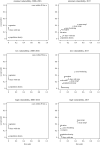Environmental determinants predicting population vulnerability to high yellow fever incidence
- PMID: 35316947
- PMCID: PMC8889195
- DOI: 10.1098/rsos.220086
Environmental determinants predicting population vulnerability to high yellow fever incidence
Abstract
Yellow fever (YF) is an endemic mosquito-borne disease in Brazil, though many locations have not observed cases in recent decades. Some locations with low disease burden may resemble locations with higher disease burden through environmental and ecohydrological characteristics, which are known to impact YF burden, motivating increased or continued prevention measures such as vaccination, mosquito control or surveillance. This study aimed to use environmental characteristics to estimate vulnerability to observing high YF burden among all Brazilian municipalities. Vulnerability was defined in three categories based on yearly incidence between 2000 and 2017: minimal, low and high vulnerability. A cumulative logit model was fit to these categories using environmental and ecohydrological predictors, selecting those that provided the most accurate model fit. Per cent of days with precipitation, mean temperature, biome, population density, elevation, vegetation and nearby disease occurrence were included in best-fitting models. Model results were applied to estimate vulnerability nationwide. Municipalities with highest probability of observing high vulnerability was found in the North and Central-West (2000-2016) as well as the Southeast (2017) regions. Results of this study serve to identify specific locations to prioritize new or ongoing surveillance and prevention of YF based on underlying ecohydrological conditions.
Keywords: cumulative logit model; environment; vulnerability; yellow fever.
© 2022 The Authors.
Conflict of interest statement
We declare we have no competing interests.
Figures




Similar articles
-
Weekly Forecasting of Yellow Fever Occurrence and Incidence via Eco-Meteorological Dynamics.Geohealth. 2023 Oct 25;7(10):e2023GH000870. doi: 10.1029/2023GH000870. eCollection 2023 Oct. Geohealth. 2023. PMID: 37885914 Free PMC article.
-
Municipalities of higher vulnerability to Sylvatic Yellow Fever occurrence in the São Paulo State, Brazil.Rev Inst Med Trop Sao Paulo. 2011 Nov-Dec;53(6):335-9. doi: 10.1590/s0036-46652011000600007. Rev Inst Med Trop Sao Paulo. 2011. PMID: 22183458
-
Spatio-temporal spillover risk of yellow fever in Brazil.Parasit Vectors. 2018 Aug 29;11(1):488. doi: 10.1186/s13071-018-3063-6. Parasit Vectors. 2018. PMID: 30157908 Free PMC article.
-
Yellow fever: the recurring plague.Crit Rev Clin Lab Sci. 2004;41(4):391-427. doi: 10.1080/10408360490497474. Crit Rev Clin Lab Sci. 2004. PMID: 15487593 Review.
-
Incidence, drivers and global health implications of the 2019/2020 yellow fever sporadic outbreaks in Sub-Saharan Africa.Pathog Dis. 2021 Apr 9;79(4):ftab017. doi: 10.1093/femspd/ftab017. Pathog Dis. 2021. PMID: 33739369 Review.
Cited by
-
Weekly Forecasting of Yellow Fever Occurrence and Incidence via Eco-Meteorological Dynamics.Geohealth. 2023 Oct 25;7(10):e2023GH000870. doi: 10.1029/2023GH000870. eCollection 2023 Oct. Geohealth. 2023. PMID: 37885914 Free PMC article.
-
A systematic review of the data, methods and environmental covariates used to map Aedes-borne arbovirus transmission risk.BMC Infect Dis. 2023 Oct 20;23(1):708. doi: 10.1186/s12879-023-08717-8. BMC Infect Dis. 2023. PMID: 37864153 Free PMC article.
-
Yellow fever in Ghana: Predicting emergence and ecology from historical outbreaks.PLOS Glob Public Health. 2024 Oct 21;4(10):e0003337. doi: 10.1371/journal.pgph.0003337. eCollection 2024. PLOS Glob Public Health. 2024. PMID: 39432459 Free PMC article.
References
-
- World Health Organization. 2018. Yellow Fever. Fact Sheets. See http://www.who.int/en/news-room/fact-sheets/detail/yellow-fever (accessed 21 July 2018).
Associated data
LinkOut - more resources
Full Text Sources

